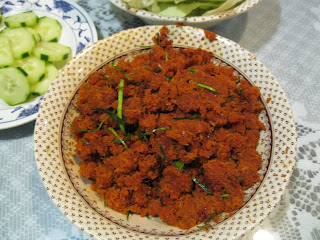Hi there,
Today, 29th Nov. 2013, mummy decided to cook "Sweet Honey Chicken Drumstick" for me. So it will give me an opportunity to record the ingredients and the methods for cooking this dish. This will enable all of you to cook this dish even when mummy is not around. I will write in as much details as I can, so that with this recipe, anybody can cook this dish. By the way, no honey is used. Beside chicken drumstick meat, other types of meat can also be used. The trick is to cut the meat into thin slices, so that a larger surface can be created to be coated with the caramel and the various sauces.
This morning, I went to the wet market to buy 8 drum sticks and I asked the lady to de-bone two drum sticks for me. She did it in front of me in 5 minutes flat, both drumsticks! I saw how she did it and I think I can do it too. Anybody who is interested in learning how to debone a chicken drumstick, I am willing to teach him or her. Unfortunately, I can't film and cut the drumstick all by myself. Somebody got to film while I debone the drumstick.
After the drumstick has been deboned, it must be cut into thin strips of about half an inch thick. The thin strips will enable the meat to be cooked quickly.
 |
| Picture 1. The chicken drum stick that has been deboned by the market lady. The meat is easier to eat. |
Then the following ingredients are added to marinate the meat:
(1) Half a teaspoonful of pepper, or more if you like it to be a bit spicy.
(2) One tablespoonful of good soya sauce, no more. (For one drumstick meat)
(3) 3 tablespoonful of white sugar -- heaps, or 4 tablespoonfuls.
(4) One tablespoonful of tomato sauce.
 |
| Picture 4. One tablespoonful of good soya sauce should be enough. More meat means more soya sauce. |
 |
| Picture 5. Put in 3 to 4 tablespoonful of white sugar. Mummy said that you can put in 4 tablespoonful of sugar for any amount of meat, as long as the caramel can coat all the meat. |
 |
| Picture 6. Finally add in a tablespoonful of tomato sauce. |
 |
| Picture 7. Mix the whole thing with two spoons until all the meat is coated with the ingredients. Store in the fridge to marinate. |
 |
| Picture 8. Use 4 cloves of garlic, skin them and them mince them. |
 |
| Picture 9. The garlic is minced before cooking. Only garlic is used in this dish. |
Mix everything thoroughly with two spoons and let it marinate in the fridge for half an hour. Mummy said that you can start frying after mixing the ingredients into the meat. No need to marinate for long.
 |
| Picture 10. You start cooking by pouring about 3 to 4 tablespoonful of oil into the wok. heat it and then add the garlic. |
 |
| Picture 11. Minced garlic is added after the oil is hot enough. Make sure the garlic is not burnt, because it will cause the dish to become bitter. |
 |
| Picture 12. The meat is then added when the garlic is aromatic. Make sure the sauces from the plate are completely poured into the wok.Stir and fry the meat constantly, searing the meat. |
Cut up four cloves of garlic into small pieces and fry this for a while first before you pour in the meat and all the sauce that were on the plate. Don't burnt the garlic. then the dish will become bitter.
Fry the meat for a while. At this point control the flame.
 |
| Picture 13. Fry the meat, searing every piece and do not allow the meat to stick to the wok. Notice the empty plate. |
 |
| Picture 15. After adding the water and stirring it, let it simmers for a while to cook the meat. Control the flame. |
 |
| Picture 17. The finished product! Sweet Honey Chicken Drumstick. It's yummy and delicious. Try it. |
After searing the meat properly, add a cup of water to the whole thing and let it cook until the meat is done. Slowly increase the flame. You must continue to fry all the time. If the ingredients are correct, the whole thing will change to BBQ meat when the water is evaporated. One of the possible source of errors is the amount of sugar. If you did not put in enough sugar it will fail. The safest thing to do is, put in 4 tablespoonful of sugar for any amount of meat, according to mummy.
Source of errors:
(1) My meat was too thick. And too long. Should be thinner and in smaller pieces. Larger surface areas.
(2) The sugar was not enough. You cannot correct your mistake half way through the cooking. You cannot put in additional sugar half way through your cooking. You have to perfect the amount of ingredients by trial and error. Use the same amount of meat each time and measure the ingredients correctly and note it down. You should be able to perfect it by the second or third trial.
(3) Mummy said the stainless steel wok was not working for her. I suggested the cast iron old fashion wok used by my grandmother and my mother. She kept quiet. She doesn't have one. She has every kind of wok except the cast iron one. DO NOT USE THE NON STICK WOK/PAN. You want the meat to be a bit burnt. Then it will be very aromatic.
Because mummy was cooking this dish, it turned out edible and I polished it off. I would say it was quite good. Try it.
Pa.























